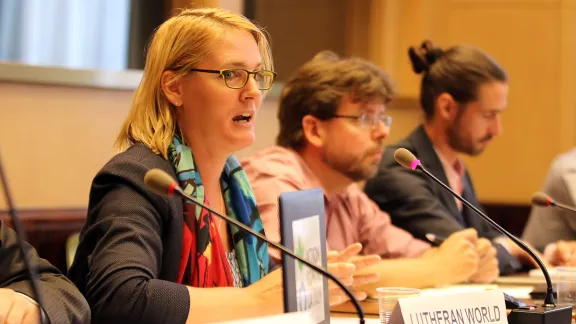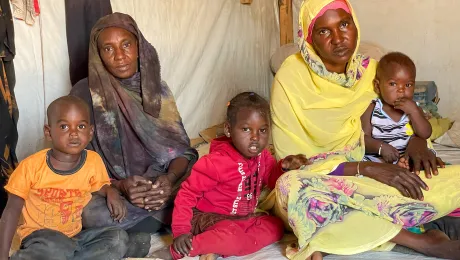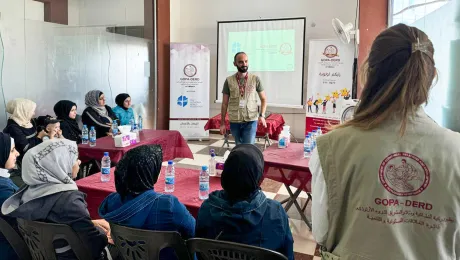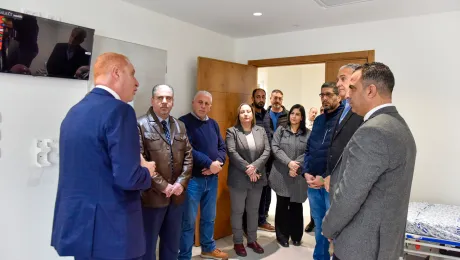
Photo: Susan Muis (center), LWF Regional program Officer for CAR, DRC and Chad, speaks at the NGO briefing in the Palais des Nations. Photo: LWF/Peter Kenny
NGO Briefing to UN member states about Central African Republic and Democratic Republic of Congo
In 2016, the Central African Republic (CAR) , where half of the population is in need of humanitarian assistance, was labeled as the most dangerous place for non-governmental organization (NGO) workers, says Susan Muis, Regional Program Coordinator for the Lutheran World Federation (LWF) Department for World Service.
She and other representatives of international NGOs spoke at a briefing for member States at the United Nation’s (UN) Palais des Nations in Geneva on 11 July, titled: “Forgotten crises in Democratic Republic of Congo (DRC) and the Central African Republic (CAR).”
ICVA (International Council of Voluntary Agencies), together with a group of NGOs in Geneva, invited LWF; Save the Children; Action Contre La Faim (Action Against Hunger); CARE and the INGO Forum, for providing a briefing about realities on the ground.
Speakers from other agencies expressed great concern about the human suffering in the Kasai region in the DRC, and the situation in Eastern CAR, while Muis elaborated on the work of LWF in the Western part of the CAR. While humanitarian access is easier than in the Eastern part of the country, it remains a complicated and dangerous place to work.
Neglected crisis
In CAR the gap between saving lives assistance and more long-term strategic development assistance is a big concern for what is known to be one of the poorest countries in the world. Muis emphasized that there needs to be investment in durable solutions. “The Norwegian refugee Council in its latest report calls the Central African Republic the most neglected crisis at the moment,” Muis said. “Half a million of people inside the country are uprooted, of which 100,000 were displaced this year. It is an alarming situation,” Muis said.
The country has a population of around five million people, but in addition to the internally displaced, 484,000 people are registered as refugees in neighboring countries, she added.
No way home
“Therefore LWF also works in Cameroon and in Chad with refugees from the Central African Republic. When we talk with them about going back home, they answer that they don’t want to go yet, because they don’t know what to expect and the security situation is too fragile. They don’t want to expose their family members again to this insecure environment,” Muis explained.
Along with providing assistance for the population in need, through provision of basic services, such as proper housing and sanitation, LWF is also looking at sustainable solutions like peace-building activities between displaced people and host communities.
“There is a need to reduce the risks of youth being attracted to armed groups. We are therefore working with local peace forums and local churches to help people generate income for families and receive psychosocial support,” said Muis. These interventions are key for increasing alternatives and creating a more positive outlook for young Central Africans.
Challenging environment
“Since the government controls only around 20 percent of the country it is really challenging for people to be present in places with high humanitarian and development needs. These places are very insecure to be operational,” noted Muis, this means that both the local population but also NGOs and other actors need more protection to do their work.
She noted that in 2016, aid workers in CAR were involved in more than 365 security incidents.
Between September and December 2016, five NGO workers in CAR were killed and 24 injured, which is the largest number of casualties after Syria.
Half a million people inside the Central African Republic are uprooted, of which 100,000 were displaced this year. It is an alarming situation.
In trying to help building peace and strengthen the local capacity “it would be sad if NGOs had to suspend their activities in the Central African Republic,” she said while facing the fact that nearly half of CAR’s population is in need of humanitarian assistance.
LWF is assisting internally displaced people (IDPs), and affected communities in the Nana Mambéré Ouham Pendé prefectures in the west and South-Western Provinces of Mambéré Kadeï and Sangha Mbaére.
Besides humanitarian assistance and focussing on needs like WASH, food security, shelter, and protection LWf also implements peace building activities for both the host communities and displaced communties to reduce tensions amongst people and create tangible income generating activities to improve their livelihood.
In DRC, LWF provides support to displaced families due to the outbreak of local violence, returnees and host community members to help them improve their own basic services which will sustain their livelihoods. LWF focus on improving their nutritional status, their environment and food security situation. Besides this we provide psychosocial support to victims and survivors of gender-based violence in these communities.


